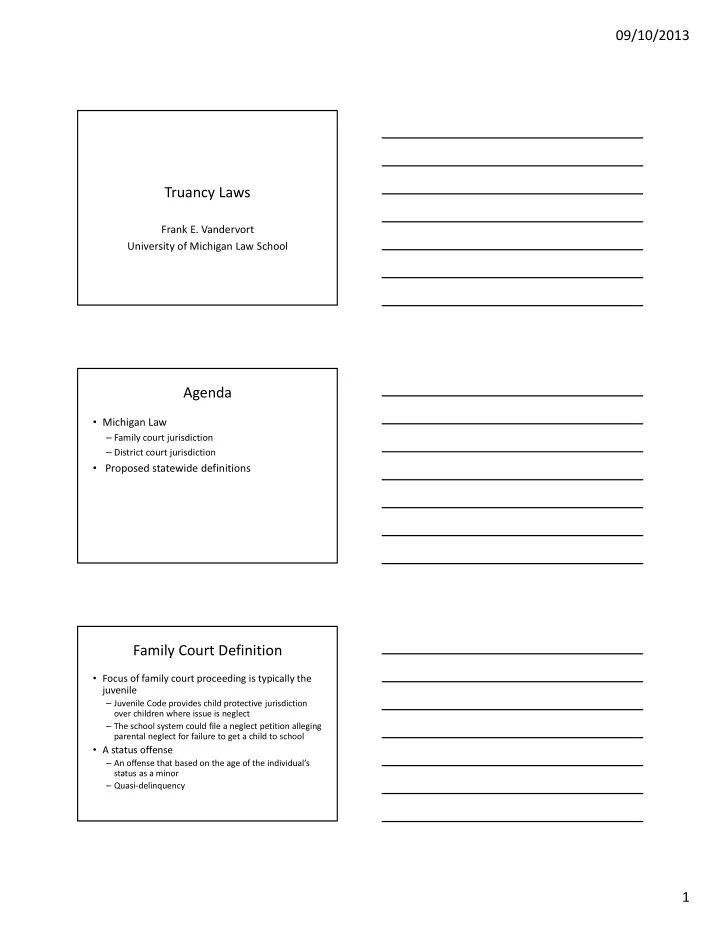

09/10/2013 Truancy Laws Frank E. Vandervort University of Michigan Law School Agenda • Michigan Law – Family court jurisdiction – District court jurisdiction • Proposed statewide definitions Family Court Definition • Focus of family court proceeding is typically the juvenile – Juvenile Code provides child protective jurisdiction over children where issue is neglect – The school system could file a neglect petition alleging parental neglect for failure to get a child to school • A status offense – An offense that based on the age of the individual’s status as a minor – Quasi-delinquency 1
09/10/2013 Status Offenses--Disposition • Status offenses have limited dispositional options for the court – JJDP prohibits secure placements for status offenses • Bootstrapping – JJDP permits the court to place in secure detention a juvenile who violates a “valid court order” Juvenile Code [MCL 712A.2(a)(4)] “The juvenile willfully and repeatedly absents himself or herself from school or other learning program intended to meet the juvenile’s educational needs, or repeatedly violates rules and regulations of the school or other learning program and the court finds on the record that the juvenile, the juvenile’s parent, guardian, or custodian, and the school officials or learning program personnel have met on the juvenile’s educational problems and educational counseling and alternative agency help have been sought. . . .” Elements of Truancy • Juvenile – 1) willfully and repeatedly absents him- herself from school or appropriate learning program or repeatedly violates school rules or regulations (e.g., tardy for class); and – 2) the parent, youth, school have met to address the problem; and – 3) Educational counseling has been sought; and – 4) Alternative agency help has been sought 2
09/10/2013 Truancy Statute Vague • But not unconstitutionally so-- • “Willfully and repeatedly absences” – “Willful”—not defined in statute • Dictionary—“done deliberately” – “Repeatedly”—not defined • Dictionary—”again and again” • Repeatedly violates the rules and regulations – Tardiness – Other behavioral problems • If child has IEP, must exhaust administrative remedies in school code before seeking family court jurisdiction. Flint Bd or Ed v Williams, 88 Mich. Pp. 499 (1979). • IDEA • No standard of evidence is specified Truancy-Michigan Law • The juvenile, the parent, and school personnel must have met to address the juvenile’s educational issues – See MCL 380.1586 (directing attendance officer to investigate, etc.) – Document—setting the meeting, the results of the meeting – Seek to identify the cause(s) of the juvenile’s truancy • Educational counseling sought • Alternative agency help – Community dispute resolution centers (mediation) Disposition • If juvenile is found to be truant, court has jurisdiction until age 19, if necessary. – In practice, courts typically don’t maintain jurisdiction for this length of time 3
09/10/2013 Q&A / Discussion District Court • MCL 380.1561 – If 11 yrs old or entered 6 th grade before December 1, 2009, parent must send child to school from age 6 until 16 th birthday • Statute does not require parental permission to discontinue – If 11 yrs old or enter 6 th grade on or after December 1, 2009, parent must send child to school from age 6 until 18 th birthday • Unless graduate earlier—e.g., 17 yrs old • Unless student is 16 and has written permission from the parent to stop attending school District Court – Notable exceptions- • 12 or 13 yr old children attending confirmation classes • Religious instruction up to two hours per week is permitted • Parent need not send the student to school if home schooling – Must utilize an “organized educational program” 4
09/10/2013 Penalty • Misdemeanor Fine—not less than $5 and not more than $50 Or Jail for not less than 2 nor more than 90 days Proposed Definitions • Currently has no single, unified, statewide definition of what constitutes truancy. – Typically combination of cumulative absences and late arrivals – Each district establishes its own definition of truancy – In some cases, individual school buildings define excused and unexcused absences Proposed Definitions • The Michigan School-Justice Partnership is working to develop a statewide definition of what constitutes “truancy” – Define “in attendance” – Define excused absences – Define unexcused absences – Define disciplinary absences 5
09/10/2013 Preventing Cases From Reaching Court • Some characteristics of model programs – Approach truancy in collaborative, multiagency fashion • A community problem • Community resources – Schools notify parents first and try to resolve the problem informally before referring to court • See, MCL 380.1586 – Assume that truancy is a symptom of more significant familial or emotional problems, and seek to identify these – Typically utilize some form of meditation (mediator independent from school) • Community dispute resolution centers 6
Recommend
More recommend